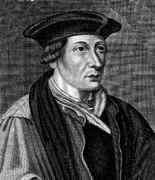Person: Fine, Oronce

Oronce Fine was a French mathematician who published a major work on mathematics and astronomy.
Mathematical Profile (Excerpt):
- Briançon, the town of Fine's birth, was in the Dauphiné so Fine wrote under the Latin name Orontius Finaeus Delphinatus, the last of these names indicating that he came from the Dauphiné.
- We are certain of the Latin form of Fine's name since this name is on his written works, but we are less certain of the French form of his name "Fine".
- Two other forms are possible, Finee or Finé but experts on the Dauphiné are clear that Fine is the form that one would expect in that region and so we have opted for this version.
- François Fine was certainly at the University of Paris in 1472-73 since copies of lecture notes of a course on Aristotle made by him in that year still survive.
- Fine was educated at the University of Paris obtaining a medical degree from the Collège de Navarre in 1522.
- Before being awarded his medical degree, Fine had edited mathematics and astronomy books for a Paris printer.
- The first book which Fine authored himself was published in 1526 and it was on the equatorium, an instrument which Fine was very interested in and which he worked on throughout his life, writing four further texts about it.
- Fine was appointed to the chair of mathematics at the Collège Royal in Paris in 1531 and he taught there from this time until his death.
- The major work which Fine produced at almost exactly the time that he was appointed to the chair of mathematics at the Collège Royal was known as Protomathesis.
- These attempts to find better approximations to π are muddled up with Fine's attempts to square the circle.
- Like many mathematicians of his time Fine was an expert on fortifications and he worked on fortifications of Milan.
- Fine was born two years after the discovery of America and when he was three years old Vasco da Gama sailed round Africa to India.
- It was natural therefore that Fine would be encouraged to use his mathematical skills in this task.
- In making maps, Fine had two distinct sources of information, one being the recently rediscovered maps of Ptolemy and others from that period, the other being the newly reported discoveries from his own time.
- Fine invented a map projection and, around 1519, he produced a map of the world using his heart-shaped projection.
- Fine also produced maps of France in 1525 and on another map of the world which he produced in 1531 with a double heart-shaped projection the name "Terra Australis" appears for the first time.
- Hapgood was particularly excited by Fine's 1531 map of the world and he began to develop rather amazing theories about the map.
- What struck Hapgood when he examined Fine's world map was that there was a fairly accurate representation of Antarctica on the map.
- Hapgood's theory that Fine was in possession of an ancient map, drawn at a time when Antarctica was not covered in sheets of ice, seems too ridiculous to discuss.
- However, we are still left with the problem of how Fine knew that Antarctica was there.
- The northern coast of Australia had probably been visited by Europeans by this time and the northern coast of Fine's Antarctica is probably drawn from such representations.
- There may also have been reports which did indeed represent the sighting of Antarctica and Fine put the reports together to produce a half real, half guessed, map.
- Of course this explanation puts the fact that Fine's Antarctica looks quite close to the actual Antarctica down to just good luck.
- Certainly this is evidence of Antarctica being confused with Australia and we suggest that Fine's 1531 map suffers from a similar confusion.
Born 20 December 1494, Briançon, France. Died 8 August 1555, Paris, France.
View full biography at MacTutor
Tags relevant for this person:
Ancient Greek, Astronomy, Geography, Geometry, Puzzles And Problems
Thank you to the contributors under CC BY-SA 4.0! 

- Github:
-

- non-Github:
- @J-J-O'Connor
- @E-F-Robertson
References
Adapted from other CC BY-SA 4.0 Sources:
- O’Connor, John J; Robertson, Edmund F: MacTutor History of Mathematics Archive
